 By Staff
By Staff
July 11th, 2017
BURLINGTON, ON
Revised at 9:30 am Tuesday morning.
The June 7th decision to close two of the city’s seven high schools stunned parents with children in both schools. Many saw it as an inevitable decision – few expected the 10-1 vote for the staff recommendation.
There were two different votes:
Bateman’s vote was 10-1
The Lester B. Pearson vote was 8-3 with the ward trustee Papin voting for non-closure.
The two high schools had different stories to tell: Lester B. Pearson was being starved of students from the feeder schools and Bateman had a great story which few people knew that much about. When the Board Director of Education decided to change his position on which high school should be closed (Bateman instead of his first decision – Central high school – there wasn’t enough time for them to get their story out and sway the 11 elected trustees who made the decision.

The Pearson parents fought against the closing of their school – they did so without the support of their trustee who never did commit herself to saying she would do everything she could to keep the school open. In the end she voted to close Bateman but to keep Pearson open. It was the first time her constituents got to see her do anything for them.
Parents at each school decided to seek an Administrative Review of the decision made by the trustees.
A request to have a decision reviewed can be made by filing a request if the the following conditions are met:
Demonstrate the support of a portion of the school community through the completion of a petition signed by a number of supporters equal to at least 30% of the affected school’s student headcount (e.g., if the headcount is 150, then 45 signatures would be required). Parents/guardians of students and/or other individuals that participated in the accommodation review process are eligible to sign the petition1
The petition should clearly provide a space for individuals to print and sign their name; address (street name and postal code); and to indicate whether they are a parent/guardian of a student attending the school subject to the accommodation review, or an individual who has participated in the review process.
Submit the petition and justification to the school board and the Minister of Education within thirty (30) days of the board’s closure resolution.
The school board would be required to:
Confirm to the Minister of Education that the names on the petition are parents/guardians of students enrolled at the affected school and/or individuals who participated in the review process.
Prepare a response to the individual’s or individuals’ submission regarding the process and forward the board’s response to the Minister of Education within thirty (30) days of receiving the petition.
If the conditions set out above have been met, the Ministry would be required to:
Undertake a review by appointing a facilitator to determine whether the school board accommodation review process was undertaken in a manner consistent with the board’s accommodation review policy within thirty (30) days of receiving the school board’s response.
What Steve Armstrong, part of the driving force behind the request, is saying is that the Board failed to follow its own Program Accommodation Review (PAR) rules
He sets out the position and the views of the Lester B. Pearson parents on just how the PAR process failed the community.
We have greatly exceeded the number of signatures required in support of asking for this review.

Steve Armstrong was not only a consistent advocate foe keeping the school open but also provided some of the best data, superior to that o the Board staff, that supported keeping the school open.
As a former Programming and Accommodation Review Committee (PARC) member I can attest first hand to many of the details in what follows.
Armstrong says he believes the intent of the PAR process was to have meaningful consultation with the communities involved and that in this regard the process failed.
He then sets out 16 different sections of the PAR policy and proceeds to set out where his community believes the Board failed.
We have set out those 16 points below along with details that WORD
What makes this particularly relevant is that the provincial Ministry of Education has admitted that there were flaws in the PAR process and put a hold on all future PAR proceedings.
That hold did not apply to the decision by the Halton Board that had already been made.
The parents at Bateman were preparing a request for an Administrative Review as well. Communication with the Bateman community is somewhat limited.
Here is the Pearson application
1) The board’s policy states:
Processes for decision‐making including those related to program, accommodation, school boundary reviews, school closures/consolidations will be timely, inclusive, transparent and open.
As will be elaborated further in the discussions below examples of a lack of timeliness, inclusivity, transparency and openness, have each been demonstrated during this process.
2) The board’s policy states:
The HDSB is committed to sharing relevant information with the public and affording affected school communities and stakeholders the opportunity for input.
Some community members sought to access information from the Board they felt was relevant to the issues at hand. Those efforts were met with roadblocks, and in one case even after filing a Freedom of Information request the results yielded an incomplete picture of the information being sought. A Trustee offered up, during delegation by that individual, that she would have gotten it for him had she known. Clearly there are inconsistent messages being sent.
3) The board’s policy states:
The HDSB will invite parents, students and staff from the school(s) under review and the broader community to participate in the pupil accommodation review process.
The PARC members took seriously their responsibility to interact with their communities, but were excluded from various process steps that would have helped facilitate those conversations.
From Director Miller’s letter to the Students on Oct 27, 2016 (a copy of the entire letter can be found in Appendix B)
As high school students your opinion is valued. The decisions made by the PAR committee will profoundly impact your school experience and those who follow you. In the new year, the PAR committee will gather feedback from Burlington high school students. We want to hear your voice!

Director of Education Stuart Miller listens to a student from Bateman speak – then later revised his recommendation to close the school.
The above paragraph erroneously setup the expectation that PARC members where making the decisions, when in fact it is the Trustees who have sole responsibility for the final call. The comment that PARC members would be gathering feedback in the new year set up an expectation that there would be interaction once the committee was up and running. Against the desires of many PARC members there was in fact no such opportunities. The student survey was conducted in December of 2016 before the PARC could review or suggest modifications to any questions. The PARC, and ultimately the Trustees, were left with only the data generated based on what HDSB thought was relevant. No opportunity to further explore the outcomes of the survey were permitted.
Likewise, the teacher/staff survey was sent out early in January before the PARC had its first working meeting.
Again no chance to shape the questions, seek follow up information, and ultimately no results were made available to either the PARC or Public at large. When asked on April 26th by a Trustee during the initial presentation of the Director’s Final Report draft where the Staff Survey results quoted in the report were, it was stated that the results contained information that would have to be heavily redacted. Ultimately the information was shared only privately with the Trustees. The PARC members and public were never given insight from this important stakeholder group.
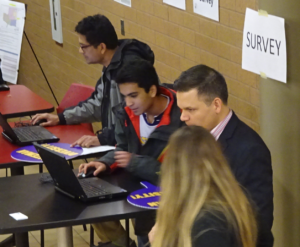
On line survey response was available at one of the public meetings – the problem was that the data was badly compromised with the wide open response process voting – people could respond as often as they wished.
The final online survey for community input was taken following the third public meeting. PARC members had asked to be involved in setting those questions, and initially were told that would be possible. Ultimately the questions were frozen without PARC input, and the results didn’t inquire on aspects we felt important to seek input on.
4) The board’s policy states:
Prior to establishing a pupil accommodation review, the Director will present to the Board of Trustees a preliminary report that identifies a school or group of schools that may be considered for a Program and
Accommodation Review (PAR) if one or more of the following conditions apply:
● The school or group of schools has experienced or will experience declining enrolment where the On the Ground (OTG) utilization rate is below 65%;
● Reorganization involving the school or group of schools could enhance program delivery and learning opportunities for students;
Much of this PAR process has centered around utilization rates of the individual high schools. The HDSB PAR policy uses a 65% Utilization rate as a trigger threshold for review. This threshold is not something that appears in the Ministry guidelines, and in fact has caused much confusion to both the PARC members and community. Given that the overall utilization in Burlington is currently sitting at 75%, and will reach 80% by 2020, this fact alone raised concerns among many as to why Burlington was undertaking a PAR itself.
Underutilization is mostly an economic factor and has little direct impact on the student experience. This stands in contrast to under enrolment which does have significant impact, mainly felt in the number of student programming options available. Conversely over utilization does have a negative impact on the student experience, especially when facilities are pushed beyond they’re total capacity. This condition exists at Dr. Frank J Hayden (Hayden) high school which is a one of the schools included in this review.
Throughout the process declining enrollment was highlighted as the root cause of all the problems.
The graph below plots the actual enrollment numbers as well as the projections from the yearly LTAPs going back to 2006
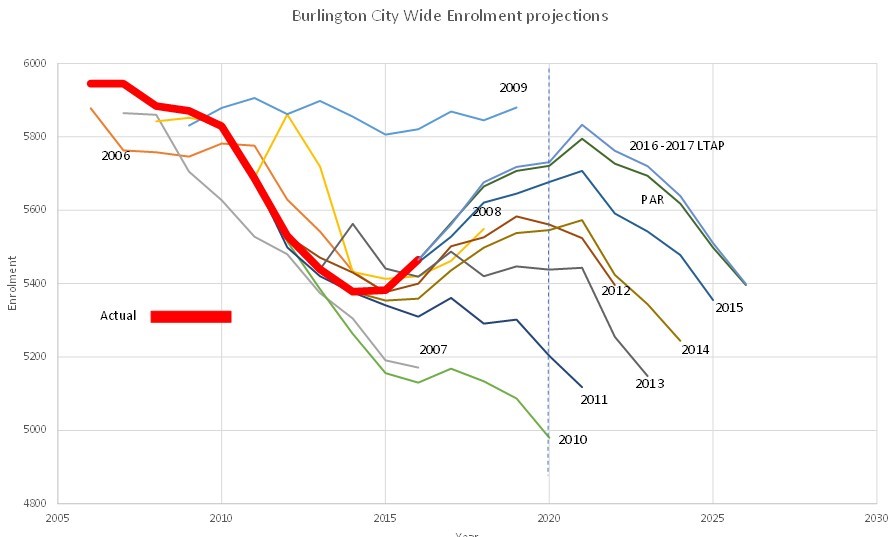
Steve Armstrong produced data that the Board didn’t refuse, showing enrollment overall had shifted and appeared to be rising.
What clearly jumps out is that for the last 2 years Burlington’s overall enrollment has in fact, been increasing, and will continue to do so for the next number of years.
The closure of Pearson and Bateman will leave approximately 5300 student places available. One can easily see the projected enrollment over the next 10 year period will be in excess of this remaining capacity.
During the PARC process the question was raised as to the accuracy of the projections. The official response was “that historically the projections have been very accurate”. A statement that is clearly not supported by the evidence. Many of the conclusions, and recommendations, have been made by focusing on the furthest point out in the projections. This data point that has in fact been historically the least accurate.
The second part of the highlighted policy concerns reorganizing to enhance programming options.
When PARC members tried to get answers as to how much better the student experience would be after closing a school or two we were always given a generic answer that failed to quantify the improvements.
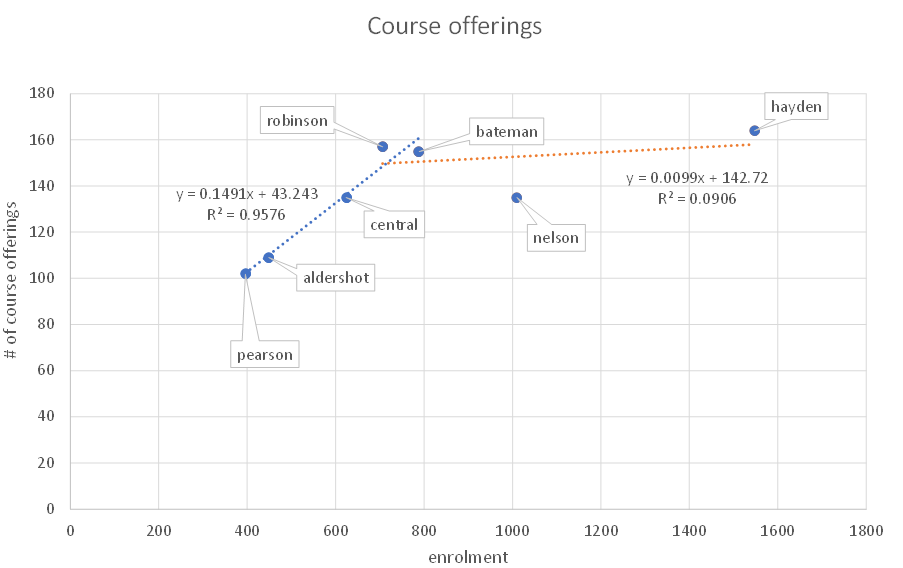
Below 700 students course options are strongly effected by enrollment, at rate of 15 courses per 100 students of change. Above critical mass the benefits of larger enrollment on the number of course options is drastically smaller.
An analysis of the SIP data much later in the process finally shed some light on the specifics and is shown above.
The data suggests that there is a critical mass that occurs around the 700 student enrollment point. Below 700 students course options are strongly effected by enrollment, at rate of 15 courses per 100 students of change. Above critical mass the benefits of larger enrollment on the number of course options is drastically smaller. What makes this very interesting is that if Burlington’s current enrollment was evenly spread over the 7 high schools there would be 780 students per school, certainly above critical mass.
Taken together these observations call into question some of the statements repeated during discussions that ultimately shaped opinions and presumably decisions.
Some of this information was present as a delegation, and the later part was only allowed to be shared as an email to individual Trustees. The process certainly has flaws. The complete document discussing these two issues can be found in Appendix C.
5) The board’s policy states:
The report must also include information on actions taken by school board staff prior
to establishing a pupil accommodation review process and supporting rationale as to any actions taken or not taken
Both the Ministry guidelines and the HDSB PAR policy talk of re balancing school enrollments in response to changing enrollments. Of the 19 Options originally developed by the Board only one explored keeping all schools open. That Option simply used capping of enrollment at Hayden to lessen the overcrowding crisis present there.
Twelve of the original nineteen options called for closing Pearson despite its’ proximity to Hayden, and completely ignored the fact that boundary changes to Pearson’s previous catchment are the root cause of Pearson’s declining enrollment. Those boundary changes were made when Hayden was opened and ultimately are now contributing to Hayden’s problems.
The Director’s Initial Report is silent on all actions taken or not taken before this process was started. Clearly the Board had awareness of the issues surrounding both Pearson and Hayden and has failed to take any corrective action, or provide the required information.
When asked by a Trustee on June 7th, the Director responded that his team had looked at boundary changes for Pearson but simply couldn’t find a scenario that fixed the problems. This is troubling in that it came up on the evening of the decision and not as an input to the PAR process as required in the PAR policy.
Additionally, it should be noted that community members had no problems developing multiple suggestions that were presented to Trustees during delegations or in emails sent directly to them. The conclusion is that neither the Board or Trustees spent much time deliberating on community inputs in opposition to their mandates.
6) The board’s policy states:
If new capital investment is required as a result of the pupil accommodation review, how the school board intends to fund this, as well as a proposal on how students would be accommodated if funding does not become available;
While this is listed as a requirement for the Director’s Initial report the original recommendation did not require significant capital outlay as City wide utilization was projected to only reach 100% of capacity.
The updated recommendations in the Final report will push overall utilization up to 110% of capacity which when combined with specialized program moves will require significant Capital funding.
The Final Report fails to explain how students would be accommodated if funding were denied.
7) The board’s policy states:
The PARC will review the completed School Information Profile(s) and have the opportunity to discuss and consult thereon.
PARC members identified a variety of errors in the first set of SIPs provided by board staff. Some of these data were corrected, but even after a second major release many issues remain. There was great concern expressed from PARC members when the projected facilities capital needs grew greatly during the revision process.

Superintendent of Facilities Gerry Cullen kept changing the data in his presentation – no one on the PARC challenged his data.
The Superintendent of Facilities explained that part of the issue was the transition to a new set of data as the Ministry was in the midst of requiring a change to the tool used for capturing capitol requests. Also highlighted by the Superintendent was the fact that forward looking projected costs are somewhat inflated to convey to the Ministry that HDSB always has need for more capital then it receives. Some fraction of the listed items will come to fruition based on actual funding provided.
Ultimately it doesn’t appear that this data was used as part of the decision making process, thus reducing the concerns of PARC members (and the public) to questioning the level of commitment of staff towards data integrity.
8) The board’s policy states:
The PARC acts as the official conduit for information shared between the Board of Trustees and school communities.
The PARC will provide feedback to the Board of Trustees and the community on the options considered in the Director’s Preliminary Report and may, throughout the PAR process, seek clarification of the Director’s Preliminary Report.
These statements imply communication is expected between the Trustees and PARC members. Unfortunately, nothing to this effect was undertaken during the PARC portion of the process. The PAR policy states that Trustees are not required to attend PARC meetings, but are free to do so. Like general members of the public they must sit in the gallery thus eliminating any interaction with PARC members. As many in the public gallery will attest it was difficult to hear the discussions going on.

There were trustees in the room for this public meeting – the trustee serving as chair literally hid in a corner of the room.
Trustee attendance at the Public meetings was also optional, and tended to usually be just the 4 Burlington Trustees plus the PARC Trustee member.
Trustees had been instructed at the beginning of the process that they were to have limited interaction with PARC, and community members. Participation at School Council meetings or other Community meetings was to be strictly in a listening mode.
Throughout the process, PARC members primary method of interaction with the Trustees was by sending emails, most of which received either no response or a short acknowledgement indicating receipt. The Board’s instructions to the Trustees greatly interfered with any thoughtful dialog. How where their questions raised and answered?
The PAR policy clearly states that PARC will provide feedback to the Board of Trustees. There was no presentation, dialog, or documents created as an output by PARC members. The Director’s Final Report simply itemized the actions undertaken at each meeting, and included the unapproved minutes in an appendix. There was no direct feedback from the PARC, only the basic proof of process.
It seems inappropriate that Trustees would receive instruction from the Board on what they can and cannot do when interacting with the constituents that elected them. The Trustees are not beholden to the Board, it is the other way around.
9) The board’s policy states:
The PARC does not need to achieve consensus regarding the information provided to the Board of Trustees and the Director
The processes used did little to encourage consensus. When a few attempts were made to use an informal show of hands to gauge the degree of any consensus these where quickly shut down by the Chair.
For any sort of meaningful consensus to be achieved all outstanding questions need to be answered, at least to some degree. Multiple times during the PARC meetings the members found themselves being asked to take Options off the table, including at the very first working meeting in January, long before clarity started forming on some of the important concepts in play. In hind sight, the process utilized at the working meetings was inappropriate.
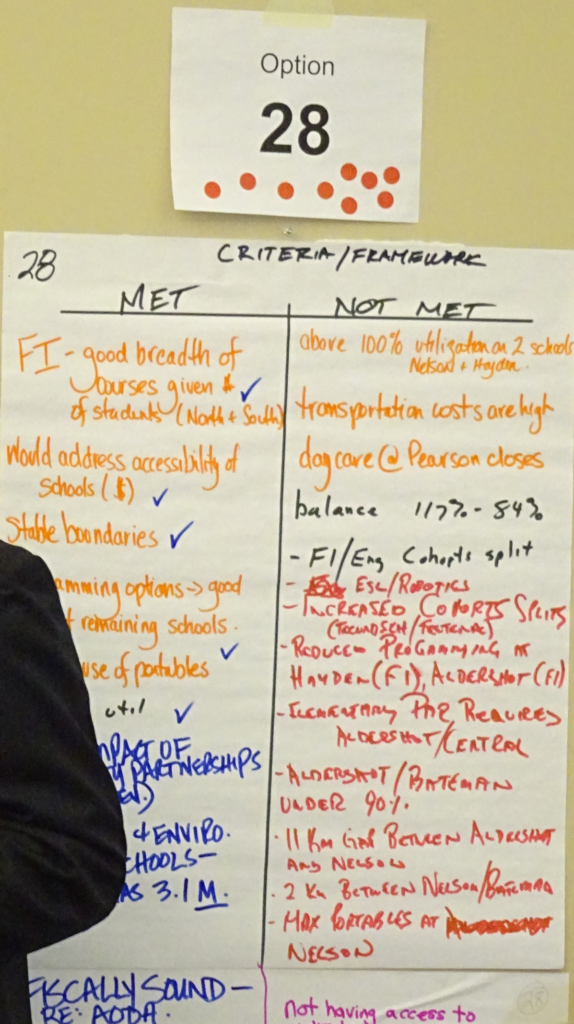
Many PARC members had problems with the use of dotmocracy so early in the process.
Discussion about what the real issues to be tackled where, and resolution of questions arising from that work are necessary before anyone should start eliminating Options. The use of a Dotmocracy exercise on the third of seven working meetings was totally inappropriate. The Options being discussed were far from being fully developed, or even the best ones to choose from.
Coming into the PARC working sessions there was a belief held by a number of the members that the Board needed to close schools in Burlington in order to receive funding for building new ones in Milton. This perception was finally laid to rest during the third meeting, but not before the consequences of that mistaken belief had impacted the process. When decisions on what Options should be removed, or added, are based on false information the damage is done. In this case it also was destructive to the collaboration needed in this process as communities had already been pitted against each other to save their school. Unfortunately, this misinformation also existed at the Trustee level as evidenced by the Vice Chair asking for clarification on this same issue during the Board meeting of May 24th. Well into the process and only a short time before the decision was to be made.
10) The board’s policy states:
Members of the PARC will solicit input from the community they represent. The format and process of the input will be discussed once the PARC is formed.
Any information requested or additional options generated by the PARC will be shared through a combination of methods including community meetings, letters to the community, website postings, school newsletters, and media releases.
At the outset of the PAR process the Board had given guidance to school administrators (Principals) concerning the interactions and support to be given during the process. This guidance apparently was not explicit enough to ensure consistent application across the 7 high schools undergoing the PAR.
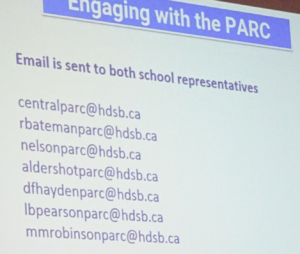
Communicating with the members of the PARC was not possible in the very early stages of the PAR – when a process was put in place it seemed convoluted to many.
It wasn’t till the end of the second working meeting that clarity was brought about allowing the board provided PARC member email address to be added to individual school websites, the control of which rests with the school Principal.
The Pearson PARC members were severely disadvantaged in efforts to connect with their community on multiple occasions. While some schools allowed PARC members to send out emails to their specific student / parent database we were denied that channel.
When we tried to engage with teachers and staff we were cut off.
While some schools even allowed community meetings to be held on site Pearson was not. Not only was there inequity in accessing school resources to enable meaningful engagement with our communities, the fundamental premise stated in the policy was not adhered to.
The Pearson PARC team was not provided any practical way to contact, meet or interact with its community. It instead had to rely on the “SaveLBP high school” team as a conduit, along with motivated parents who sought out the PARC email addresses. Neither mechanism ensured the broadest engagement.
11) The board’s policy states:
The secretary of the PARC will be responsible for preparing detailed minutes of all meetings.
Once approved by the PARC, the minutes will be posted on the Board’s website.
Minutes were never approved. Procedurally they were emailed out to PARC members, who invariably requested additions or corrections, some of which were incorporated others of which weren’t. At no time was the committee asked to approve the minutes either during a subsequent working meeting, or by email.
Since the minutes were the only correspondence included in the Director’s Final Report as output from the PARC there is a significant under representation of that group’s thinking.
12) The board’s policy states:
The Board of Trustees encourages PARCs to be clear about the challenges and opportunities being addressed and work actively to identify and promote shared values and interests
This is an area where the PAR process as whole has performed poorly.
When the committee members sought clarity on the specifics of the original challenges and opportunities as presented the answers were generalizations that didn’t quantify either the downsides or upsides. Moving forward making decisions on which Options to continue discussing early on was inappropriate.
13) The board’s policy states: PARC Framework
In respect of the school or group of schools being studied, the PARC will consider, but not
be limited to the following:
Accommodation of students in permanent school facilities and minimal use of portable classrooms;
Balance of overall enrollment in each school in the area to maximize student access to programs, resources, and extra‐curricular opportunities and avoid over and under-utilization
of buildings;
Fiscal responsibilities;
The Final Recommendations and decisions made on June 7th leave Dr. Frank J Hayden high school in a significant overcrowding situation over the next 2 years, and are dependent on student/parent choices regarding participation in the optional French Immersion program at MM Robinson high school to bring down the stresses being felt by the students at Hayden in the long term. Over the full 10 year period of the LTAP projections this school is not projected to see its enrollment brought down to the OTG capacity of the building.
Consequently, the decision made will not reduce the use of portables over the next 10 year period. This later aspect deprives the residents of Burlington the full enjoyment of the sports fields, library and community center gymnasiums during the evenings and weekends.
From a fiscal perspective, the decision to close two schools and immediately require $12M (or more) to reproduce what already exists at Bateman clearly calls into question whether the Board and its Trustees have failed to protect the financial interests of Ontario taxpayers in the near term when enrollment is growing. The decisions made also greatly increase the risk of needing further major capitol funding if the current pattern of increasing enrollment projection in the 5 – 10 year horizon continue.
14) The board’s policy states:
The affected local municipality, the Region of Halton, as well as other community partners that expressed an interest prior to the pupil accommodation review will be encouraged to provide their responses on the recommended option(s) in the Director’s Preliminary Report before the final public meeting.
The Ministry guidelines use much stronger language and state that:

City council chose to say little about the possible closing of high schools – in this photograph three of the seven council members took part on a public meeting.
The affected single and upper‐tier municipalities, as well as other community partners that expressed an interest prior to the pupil accommodation review, must provide their response on the recommended option(s) in the school board’s initial staff report before the final public meeting.
Similar requirements surround documenting any relevant information in the Final Report.
The Board has failed on to provide this perspective in any of its reports, including acknowledging letters written by City Councilors opposing the Board recommended closures.
15) The board’s policy states:

Director of Education Stuart Miller
The Director’s Final Report will include a community consultation section that contains feedback from the PARC and any public consultations, as well as any relevant information obtained from municipalities and other community partners prior to and during the pupil accommodation review, and for transparency, identifies key considerations in formulating the final recommendations to the Board of Trustees.
The Director will consider all input received in developing recommendations.
Feedback from the public delegations will be compiled and included as information to the Board of Trustees together with the Director’s Final Report.
The Director will present the Final Report, including the compiled feedback from the public delegations, to the Board of Trustees.
The Director’s Final Report is deficient in providing feedback from public delegations, public consultations, and municipalities, thus calling into question how much consideration was given to these inputs if at all.
16) The board’s policy states:
There must be no fewer than ten (10) business days between the date of the public delegations and the final decision of the Board of Trustees.
Given that public delegations occurred on June 7th, the same evening as the final decision was being made, it is a trivial thought process to see that a clear deviation from the PAR policy occurred.
Given the above policy violation, and the immediacy in which prepared statements were made by Trustees during the decision making portion of the meeting, it is quite clear that thoughtful deliberation could not have occurred.
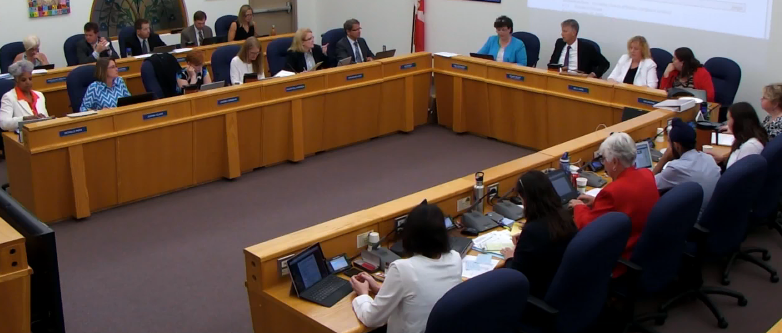
The trustees were put in the very difficult position of not having some critical information and at the same time being bombarded by more than 700 emails.
Many Trustees lamented that they had read all the over 700 emails, listened to the numerous voicemail messages, and phone calls received. Combined with the knowledge that the clear majority of this occurred post the PARC phase, and post the release of the draft of the Director’s Final Report, when any questions arising would be answered solely from the Board’s perspective, without any engagement with the community, it becomes easy to understand the appeal of the Board’s recommendations
In summary:
It is consideration of all the above, we the petitioners believe that HDSB did not follow its Programming and Accommodation Review policy, and request that a you undertake an Administrative Review of the process leading up to the decisions made on June 7th, 2017




















Thanks again, Steve. Your careful analysis and precise data have been an inspiration to our community since the beginning of this debacle. As an update, my request for feedback to our MPP regarding Mitzies’ decision to pause all school closures and PAR in Ontario in relation to the Administrative review received no response from the MPP, or HDSB and only a cursory response from our Trustee. Must be a busy time of year on Lake Joe, Rosseau etc. while students and parents suffer in limbo.
I am glad you have shared this request for a review. It seemed like there were too many issues that need to be looked at before closing either school.
I believe our Burlington MPP Ms. Eleanor McMahon is in hiding because she is a member of the Wynne Liberal Ontario government that is selling assets and claiming a balanced budget.
There are apparently some 121 or 122 schools across Ontario that are being closed or proposed for closure which affect some 33,000 Ontario pupils.
Burlington residents do not forget the actions of the Wynne Liberals and our local politicians during 2017 when you come to vote next June in 2018!
Thank you Steve for sharing and highlighting the flaws in the whole process. Even the Ministry recognizes the flaws but only on issues moving forward. Would love to understand their logic behind that one. If something is so flawed, you call a halt to it to a) reassess and b) correct how do you honour decisions made/performed under such a flawed system. Any on-going ones or ones from the start of the year (or determine the time-frame, where land etc. hasn’t been sold) should also be halted.
What a brilliant move to put the LB Pearson request for an Administrative Review of the Halton District School Board Director of Educations and Trustees decision to close Lester B Pearson High School into the local news media!
This will allow all of Burlington to be aware of the farce conducted by the HDSB Director and Trustees.
Hopefully this will influence their request to review their vote to close LB Pearson and R Bateman high schools … but I fear it will not
But this will influence the population of Burlington in their voter choices next year.
Wow! Well done Steve Armstrong! You present a pretty compelling argument in favour of an administrative review.
It will be interesting to see the response to this request. I will be watching eagerly how the powers that be respond to his arguments.
And again, as I have said many times: where is our MPP in all of this? Is she on leave, vacation, or does she just not care? Her noticeable silence throughout this debate is very telling. I sent her an e-mail over three weeks ago on another topic, and I’m still awaiting a response. Unbelievable!!